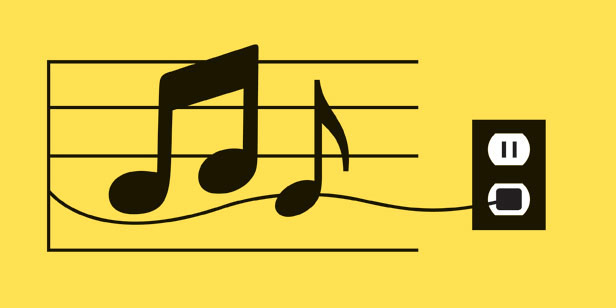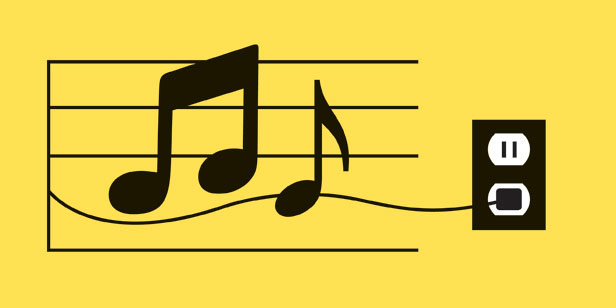

Business Impact
Can Creativity be Automated?
Computer algorithms have started to write news stories, compose music, and pick hits.

In 2004, New Zealander Ben Novak was just a guy with a couple of guitars and distant dreams of becoming a pop star. A year later one of Novak’s songs, “Turn Your Car Around,” had invaded Europe’s radio stations, becoming a top-10 hit.
Novak had to beat long odds to get discovered. The process record labels use to find new talent—A&R, for “artists and repertoire”—is fickle and hard to explain; it rarely admits unknowns like him. So Novak got into the music business through a back door that had been opened not by a human, but by an algorithm tasked with finding hit songs.
It’s widely accepted that creativity can’t be copied by machines. Reinforcing these assumptions are hundreds of books and studies that have attempted to explain creativity as the product of mysterious processes within the right side of the human brain. Creativity, the thinking has been, proves just how different people are from CPUs.
But now we’re learning that for some creative work, that simply isn’t true. Complex algorithms are moving into creative fields—even those as nebulous as music A&R—and proving that in some of these pursuits, humans can be displaced.
The algorithm that kindled Novak’s music career belongs to Music X-Ray, whose founder, Mike McCready, has spent the last 10 years developing technology to detect musical hooks that are destined for the charts. When Novak submitted a song to McCready’s engine through the Web, it was graded on a par with classic hits such as “Take It Easy” by the Eagles and Steppenwolf’s “Born to Be Wild.”
Music X-Ray’s algorithms use Fourier transforms—a method of separating a signal from the “noise” of complex data—to isolate a song’s base melody, beat, tempo, rhythm, octave, pitch, chords, progression, sonic brilliance, and several other factors that catch a listener’s ear. The software then builds three-dimensional models of the song based on these properties and compares it with hit songs of the past. Putting a just-analyzed song on the screen with No. 1 tracks of yore shows a kind of cloud structure filled in with dots representing songs. The hits tend to be grouped in clusters, which reveal similar underlying structures. Get close to the middle of one of those clusters and you may have a hit.
McCready’s website and software have now connected more than 5,000 artists with recording deals, and after a long period of shunning him, the A&R industry is regularly using Music X-Ray to find new artists. “I’m finally making friends in the record industry,” McCready says.
Music lends itself naturally to being parsed by algorithms—mathematics is mixed up in every chord, beat, and harmony that we hear. But can computer programming hack something as subjective as grading English papers?
Why, yes. Earlier this year the William and Flora Hewlett Foundation sponsored a $100,000 competition that invited programmers to build the best essay-grading bot possible. The ultimate goal: an algorithm that closely tracks marks given by the most competent human graders. The best of the 159 submissions did exactly that, producing scores nearly identical to those given by a pool of humans. Such a tool could improve the productivity of teachers who must slog through hundreds of student essays. It could also reintroduce essays to a wider set of standardized tests, which have become dominated by multiple-choice questions that can be cheaply scored by machines.
Algorithms won’t only do work that requires a critical eye. They also will create. Narrative Science, a company in Evanston, Illinois, whose founders include journalism and computer science professors from Northwestern University, has built a set of algorithms that take box scores and produce well-styled and grammatically correct sports reports. The Big Ten Network uses the technology to produce stories one minute after a game is over. An article duly punched out by the bot seconds after an Illinois-Indiana football game started like this: “Nathan Scheelhaase threw for 211 yards and three touchdowns and rushed for 95 yards and one touchdown, leading No. 16 Illinois to a 41-20 victory over Indiana on Saturday at Memorial Stadium. Illinois’ (6-0) offense dominated, ripping off huge chunks of yardage.”
Bots can’t yet script prose worthy of awards, but on some metrics of economic importance to publishers—such as number of page views a site registers—bots can be far more productive than any journalist. They can write articles in seconds, even about events that no journalist attended.
So at what point do algorithms produce something really creative, like art? David Cope, a professor emeritus at UC Santa Cruz, believes we’re nearly there. Cope has been weaving thousands of lines of LISP code into music-making algorithms for 30 years. While his first algorithms produced crude music unfit for public performance, his newer ones have consistently composed classical music that imitates masters like Johann Sebastian Bach so well that people can’t always tell the difference.
Cope feeds music to machine learning algorithms that create new compositions by changing and building on patterns it finds in existing music. Some might call this mere plagiarism. But Cope argues that building upon the past is what great musicians and composers have always done. This, he insists, is creativity.
Cope’s latest algorithm, which he’s dubbed Annie, takes programmed creativity yet a step further. She decides on the musical patterns, the criteria, and ultimately, the path she takes to making music. “The really interesting thing is that I have no idea what she’s going to do sometimes,” Cope says. “She surprises me as much as anybody.”
Christopher Steiner is an author and entrepreneur. His forthcoming book Automate This: How Algorithms Came to Rule Our World is being published by Portfolio/Penguin in August.
Advertisement